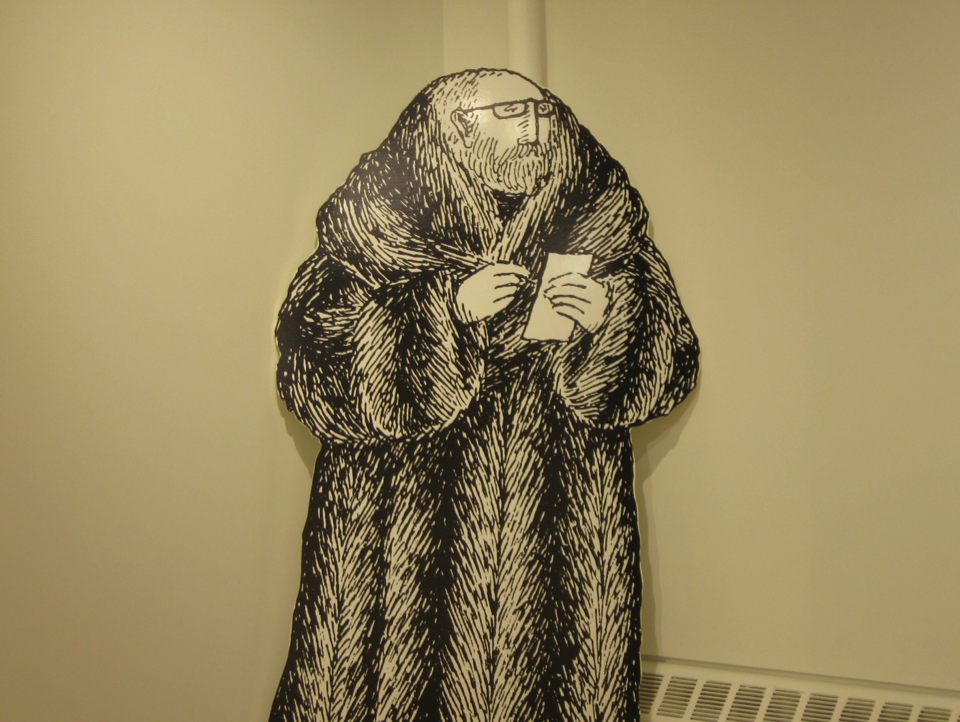Connector Contributor
On South Campus this month, there is an amazing opportunity for students and teachers alike in Mahoney Hall’s University Gallery. The work of Edward Gorey, an artist renowned for his Victorian-esque, darkly humorous pen and paper style of art, is on display in the exhibit “E is for Elephant: The Etchings of Edward Gorey.” Free to enter, the gallery boasts work from the last decade of Gorey’s life. Gorey passed away in 2000, but his work lives on in this expertly arranged display of some of his finest work.
The display was put together by UMass Dartmouth’s James Edwards, the Curator of this gallery, alongside UMass Lowell’s gallery coordinator and put on by the Department of Art & Design. When asked “What makes Edward Gorey special and his work significant?” Gallery Coordinator Deborah Santoro replied that his book illustrations were especially fascinating and described his work as having a “Victorian style” with a “creepy edge.”
Gorey worked almost exclusively in black and white, with occasional bursts of color and he focused mostly on animals and children in his art, though he occasionally deviated. Gorey’s early work is often found in book form, in a sort of parody of children’s books. In what is likely his most famous book, “The Gashlycrumb Tinies” (1963), Gorey explores the alphabet, as many children’s books do, but does so with toddlers who meet a premature demise. For example, the letter “I” stands for Ida, a child who drowned: and who could forget the shocking image accompanying the sentence “K is for Kate who was struck with an axe.” This same art style was applied to the intro sequence for “PBS Mystery!” some years ago, which wildly popular with its dark themes, but charm and poise as well.
Most of the work featured in the exhibit was not created in his characteristic pen-and-paper style, but were made with etchings and prints he was fond of using toward the end of his career As the name of the exhibit may suggest, many of the prints are different interpretations of or take inspiration from the elephant. Edward Gorey was an animal lover, especially of elephants and cats which he would incorporate into his work. Gorey championed animal rights movements and donated to a number through his will, including an elephant sanctuary. The majority of the exhibit displays his etch-and-print style elephants, in various poses and with different art styles applied.
The gallery itself contains a number of his works, all of which are worth a look. Around the room there are a number of mediums to show his body of work. In the main room there are prints on every wall, as well as a life-size cut-out of the character Gorey based on himself. In the center of the room lies the etchings used to print, as well as concepts and thumbnails Gorey used to get his finished products. On the back-left wall is a television showing pictures of Gorey’s house, now turned into a living memorial to the man and his art.
To the right of that is a small reading area, where attendees can read some of his most popular books. In the next rooms are more prints, including his graceful Figbash character and an elephant-human hybrid known as Elephantômas. In this room is also a computer, running on a loop the spectacularly designed and amazingly popular introduction and exit scenes for “PBS Mystery!”
To accompany the exhibit there will be a talk given by the collection’s curator, Edwards. He will be talking about Gorey and his work in O’Leary Library room 222 on Tuesday, Sept. 15 at 5:30 p.m. After the discussion there will be a reception in the University Gallery in Mahoney Hall from 6:30 p.m. – 8 p.m. If you have not yet visited this beautiful collection, you have not missed your chance yet! The exhibit will remain open until Oct. 16.




